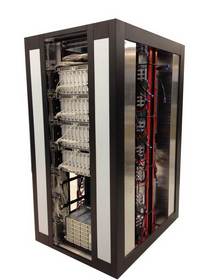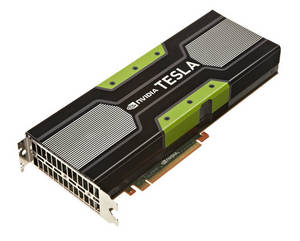SANTA CLARA, CA--(Marketwired - Jun 28, 2013) - NVIDIA today announced that NVIDIA® Tesla® GPU accelerators are powering the world's two most energy efficient supercomputers, based on the latest Green500 list published today.
The winning system is 'Eurora' at CINECA, Italy's largest supercomputing center, in Casalecchio di Reno. Equipped with NVIDIA Kepler™ architecture-based GPU accelerators -- the highest-performance, most efficient accelerators ever built -- Eurora delivers 3,210 MFlops per watt, making it 2.6 times more energy efficient than the best system using Intel CPUs alone (at Météo France). It also greatly surpasses the most efficient Intel Xeon Phi accelerator-based system, 'Beacon,' at the National Institute for Computational Sciences, at the University of Tennessee.
The number-two system on the June 2013 Green500 list is the 'Aurora Tigon' supercomputer at the Selex ES facilities Chieti, Italy.
These top two systems are powered by advanced Eurotech high-performance 'Aurora' servers, equipped with NVIDIA Tesla K20 GPU accelerators.
More broadly, NVIDIA Kepler GPU accelerator-based systems in the top 100 spots on the Green500 list are 50 percent more energy efficient on average than the latest Intel Xeon Phi-based systems.
Following last week's ISC 2013 Student Cluster Challenge in which NVIDIA GPU accelerator-based systems swept the top four spots for energy efficient supercomputing, NVIDIA GPUs again demonstrated why they are most preferred accelerator solution among developers, system designers, and computational researchers.
"Raw performance is no longer the exclusive measure of the value and impact of supercomputers," said Sumit Gupta, general manager of the Tesla Accelerated Computing Business Unit at NVIDIA. "All future systems will need to deliver higher performance with reduced power consumption. With GPU accelerators in the top two spots, the latest Green500 list demonstrates accelerators' ability to deliver unmatched levels of energy-efficient supercomputer performance for next-generation systems."
By delivering thousands of small energy efficient cores operating in parallel, GPU accelerators are considerably more energy efficient than standard CPUs. These GPU cores are optimized to run the compute-intensive portions of applications, while general-purpose CPU cores, which process in serial, are highly inefficient when running compute-intensive applications.
Issued twice annually, the Green500 list rates the 500 most energy efficient supercomputers based on performance achieved relative to power consumed. For more information and the complete June 2013 Green500 list visit: http://green500.org/.
About NVIDIA Tesla GPUs
NVIDIA Tesla GPUs are massively parallel accelerators based on the NVIDIA CUDA® parallel computing platform and programming model. Tesla GPUs are designed from the ground up for power-efficient, high performance computing, computational science and supercomputing, delivering dramatically higher application acceleration for a range of scientific and commercial applications than a CPU-only approach.
To learn more about CUDA or download the latest version, visit the CUDA website. Follow us on Twitter at @NVIDIATesla.
About NVIDIA
Since 1993, NVIDIA (
Certain statements in this press release including, but not limited to, statements as to: the impact and benefits of NVIDIA GPU accelerators are forward-looking statements that are subject to risks and uncertainties that could cause results to be materially different than expectations. Important factors that could cause actual results to differ materially include: global economic conditions; our reliance on third parties to manufacture, assemble, package and test our products; the impact of technological development and competition; development of new products and technologies or enhancements to our existing product and technologies; market acceptance of our products or our partners' products; design, manufacturing or software defects; changes in consumer preferences or demands; changes in industry standards and interfaces; unexpected loss of performance of our products or technologies when integrated into systems; as well as other factors detailed from time to time in the reports NVIDIA files with the Securities and Exchange Commission, or SEC, including its Form 10-Q for the fiscal period ended April 28, 2013. Copies of reports filed with the SEC are posted on the company's website and are available from NVIDIA without charge. These forward-looking statements are not guarantees of future performance and speak only as of the date hereof, and, except as required by law, NVIDIA disclaims any obligation to update these forward-looking statements to reflect future events or circumstances.
© 2013 NVIDIA Corporation. All rights reserved. NVIDIA and the NVIDIA logo, Kepler, and Tesla are trademarks and/or registered trademarks of NVIDIA Corporation in the U.S. and other countries. Other company and product names may be trademarks of the respective companies with which they are associated. Features, pricing, availability and specifications are subject to change without notice.
Contact Information:
For further information, contact:
George Millington
NVIDIA Public Relations
(408) 562-7226
gmillington@nvidia.com

